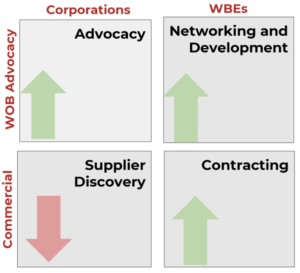Lessons Learned from the Field: Supplier Diversity and Inclusion
As an award-winning company in the area of inclusive procurement and WBENC certified women’s business enterprise (WBE), DAI is passionate about making sure supply chains are inclusive.
In a previous post, we describe the best practices of a world class supplier diversity program.
Preliminary Step: Track and count spend.
Step 1: Secure Executive Support.
Step 2: Engage with the Community
Step 3: Clearly identify company roles and responsibilities
Step 4: Embed supplier diversity and inclusion into company culture and integrate it with Diversity, Equity, and Inclusion goals.
Step 5: Operationalize Excellence.
Step 6: Develop capacity of suppliers.
Based on our work with supplier diversity professionals and with Women’s Business Council Southwest (WBCS), which is one of WBENC’s 14 regional affiliates, we offer a deep dive below into what corporations are doing to meet this moment and how they can engage with partners and stakeholders to achieve the full potential of supplier diversity and inclusion programs.
Moving from Performative to Transformative
Once a company has secured executive support for supplier diversity, it’s key to understand the landscape of boosters and obstacles to going from a performative supplier diversity program to one that truly transforms the organization and unlocks the promises of these best practices.
We describe this as moving from a supplier diversity program to a supplier inclusion strategy. Companies need to evaluate several factors as they make the transition:
- Five roles that supplier diversity professionals play in their organizations
- What’s needed jump start supplier diversity and inclusion programs
- Tools to move to the next level
- What’s next for successful organizations

Roles of Supplier Diversity and Inclusion
We found that not only do procurement processes vary widely within and across organizations, but also that the influence that supplier diversity champions have over these processes also varies.
Acting as advocates for diverse suppliers in their supply chains, supplier diversity representatives sit at the intersection of the following factors:
- Spend. Influencing spend is one of the most straightforward roles that supplier diversity executives play in an organization and one of the most visible. At its most fundamental level, supplier diversity is responsible for achieving goals for the number of dollars spent with diverse suppliers.
- Process. Process is one factor that can vary widely within supplier diversity’s sphere of influence. Flexible and accommodating processes are necessary to change vendors and to account for the constraints on small and medium sized businesses in terms of legal, insurance, and financing resources. For example, even with a mandate to increase spend with diverse suppliers, supplier diversity may have limited influence over the contracting processes which require lengthy and costly negotiations. Sometimes companies extend payment terms to 90 or 120 days or longer such that small business owners are forced to finance a project out of pocket before receiving payment.
On the other hand, when supplier diversity has some influence, they can ensure that diverse suppliers have shorter payment terms. Some organizations offered immediate payment to diverse suppliers at the beginning of the pandemic. Others have translated major organizations’ extended payment terms into an opportunity. In 2021, Meta unveiled a program to finance diverse suppliers with only 1% interest.
Payment terms, while often cited by diverse suppliers, are only one of the many ways the process can hamper supplier diversity efforts.
- Geography. When procuring goods and services, supplier diversity executives need to consider the role geography plays in projects of all sizes. While one project with a global company may require a vendor with global capabilities, another may be local in scope.
Sustainable business practices dictate that purchasing goods and services locally cuts down on a company’s carbon footprint. Economic development advocates point out that purchasing locally stimulates local economic growth.
Supplier diversity professionals need to juggle competing geographic needs of the project with capabilities of the suppliers.
- Categories. Supplier diversity is often responsible for finding suppliers for different spend categories: direct or indirect procurement, technology, marketing, promotional products, etc. without insight into when these categories will be needed. Along with understanding the categories and specs for different projects, insight into budgeting and forecasting varies in different companies and supplier diversity roles.
A good example of when this becomes critical is during events and conferences. Investing in a supplier diversity event may come with a booth, meet and greets, or opportunity for matchmakers. That investment may come on top of other expenditures like membership or leadership in an organization. To maximize that investment, supplier diversity professionals need to be proactively sourcing for needs that will happen 6, 12, or 18 months out. A representative who is prepared with this information may disappoint the suppliers that are not on that list. But ultimately, they are saving them time too. When there is not a strategic focus on categories, supplier diversity professionals are inundated with suppliers, overwhelmed, and both they and suppliers become frustrated.
- Buyers. Several factors influence supplier diversity’s relationship with buyers including organizational policies, processes and politics. A key part of being able to influence buyers is leverage, or accountability for including diverse suppliers. The role of supplier diversity varied not only across companies but within companies across different buying categories. For example, construction buyers may have goals and targets that facilitate working with supplier diversity, whereas marketing or legal departments may be functionally exempt from those targets.
Some companies have supplier diversity advocates that sit in different departments such as marketing, legal, or technology. They become accountable for that team’s utilization of diverse suppliers and thus have a vested interest in making sure that they are working with, and not against, supplier diversity in the areas of spend, process, geographical concerns and buyer relationships.

Jump Starting Supplier Diversity and Inclusion
Given the challenges that supplier diversity and inclusion professionals face in their roles within their companies, supplier diversity organizations fill a critical role in the ecosystem. When these relationships evolve strategically as corporate needs shift, ecosystem partners market diverse businesses to corporations highlighting the breadth and depth of suppliers in a range of categories. They are also able to provide a vetting and strategic sourcing role, when they know what corporate partners need.
Currently, when supplier diversity executives engage with the ecosystem they get support from the organizations they work with in the form of advocating for diverse businesses, providing networking and development to grow their capacity, and contracting with diverse businesses for an immediate need.
One thing that we found was missing was a strategic component of supplier diversity procurement processes: Supplier Discovery.
In order to engage ecosystem partners in supplier discovery, there is untapped potential for supplier diversity professionals to engage with ecosystem partners.

Together they can work to:
- Identify and forecast category demand. To expand on the example above, when a supplier diversity professional invests in a sponsorship or membership in an organization, they maximize that investment when they come to the events ready to engage with suppliers in specific, strategic categories. To the extent they share their needs with their organizational partners, the supplier diversity organizations can perform that role of strategically sourcing specific categories, while still being inclusive of all industries.
- Curate portfolio of suppliers by categories, services, or industry. Once the suppliers in the desired categories are identified, they can work with organizational partners to get a portfolio of those suppliers matched to their needs. This allows each stakeholder in the relationship – corporate member, organizational partner, and diverse business – to showcase their value.
- Conduct table top “matching” events to track demand and supply conditions. As we saw during COVID-19, one thing that hindered the connections between these corporations and potential suppliers was not being able to meet in person. While the behind the scenes work of the supplier diversity team and organizational partner lay the foundation, providing programs to meet and recruit these suppliers will help evaluate how the sourcing is going.

COVID-19 prepared us to adopt new tools to move to the next level
Delivering services virtually led to new challenges in terms of making connections and building relationships in the network. At the same time, adoption of new methods of connecting and relating offers some ways that supplier diversity teams can maintain additional capacity, even as we are afforded more opportunities to connect in person.
Some recommended tools:
- Streamline and automate operations to create additional capacity. Certification workshops, process questions, and tasks that are repeatable would benefit from being scaled and automated.
- Build in high touch outreach externally and internally. By automating some processes, that would allow for flexibility in staff time to provide a higher touch and more customized level of service for organizational priorities, like outreach to corporate members and WBEs.
- Fully engage with ecosystem partners for outreach and community building. Utilize the capacity that organizational partners developed to conduct outreach virtually to enhance the supplier discovery functions and support roles they can play for your organization.

What can our work on supplier diversity and inclusion tell you about what’s next for your organization?
Perhaps your company is one of the founding members of NMSDC and WBENC and has been growing a supplier diversity and inclusion program for decades. Or perhaps your company is relatively new to supplier diversity and just starting to formalize your processes. Wherever you are in that journey, the past few years has changed the landscape for diversity equity and inclusion and supplier diversity. To ensure your company has the maximum impact on those objectives, you’ll want to take a holistic look at what your objectives are and whether the status quo will achieve them. Chances are, you would benefit from an assessment of where you are and where you want to go, particularly given the emerging trends in the industry.

As we describe in our best practices overview, companies that elevate their supplier diversity programs to supplier inclusion strategies experience the following benefits:
- Integration with Diversity, Equity and Inclusion (DEI) Strong supplier diversity and inclusion procurement programs come from a company-wide commitment to Diversity, Equity and Inclusion. Beyond the organizational and operational benefits and compliance requirements, studies show that a more diverse environment reaps financial benefits. Investors and company leaders have started to pay more attention to this key profitability measure. Diversity, Equity and Inclusion programs are proven to increase employee engagement and trust, create a work culture that embraces new perspectives and encourages innovation. Better decision-making and improved performance result in stronger business performance and profits.
- Integration with Sustainability and Socially Responsible Business Practices The time of transformation includes transforming business practices so they are responsive to the demands of environmental and social issues. Supplier Diversity and Inclusion programs are a gateway program to other socially responsible business practices. The best programs are embedded in existing procurement practices and provide lessons for demonstrating your values through core business operations and policies. In fact, UN Women recently released a report on the importance of Gender Responsive Procurement which highlights what steps multinational companies are taking to increase and improve their inclusive sourcing programs. The correlation between responsible and sustainable business practices and overall business success has never been more clear.
- Mitigating Supply Chain Issues Easing of pandemic restrictions did not bring with it the easing of supply chain issues. Across industries, major purchasing organizations are struggling with getting what they need when they need it. Companies have implemented various strategies to address those challenges, including having a bench of qualified suppliers, purchasing locally so that goods and services can more easily reach their destinations, and re-evaluating procurement processes that rely on a limited number of suppliers.
- Engaging employees in the new workplace. When it comes to DEI and Socially Responsible Business practices, employees value, and even demand, that their companies’ policies align with their values which include social and environmental change and transformation. If your human capital management strategy has not yet shifted, it will likely need to in order to compete. As your supplier diversity and inclusion program moves to the realm of strategy and is integrated across business functions, it will involve your employees in work that aligns with their values.

In order to understand your organization, you need to understand if you’re most of the impacts of your supplier inclusion programs. If so, are you communicating these benefits to your customers, suppliers and vendors? DAI works with clients to ensure they are taking full advantage of the potential of your supplier diversity program. Our consultants can take you through our methodology and approach to make your supplier diversity efforts transformative.
To see the Q&A with myself click here. Find out more about our award winning supplier diversity services on our page or contact us for more information.

